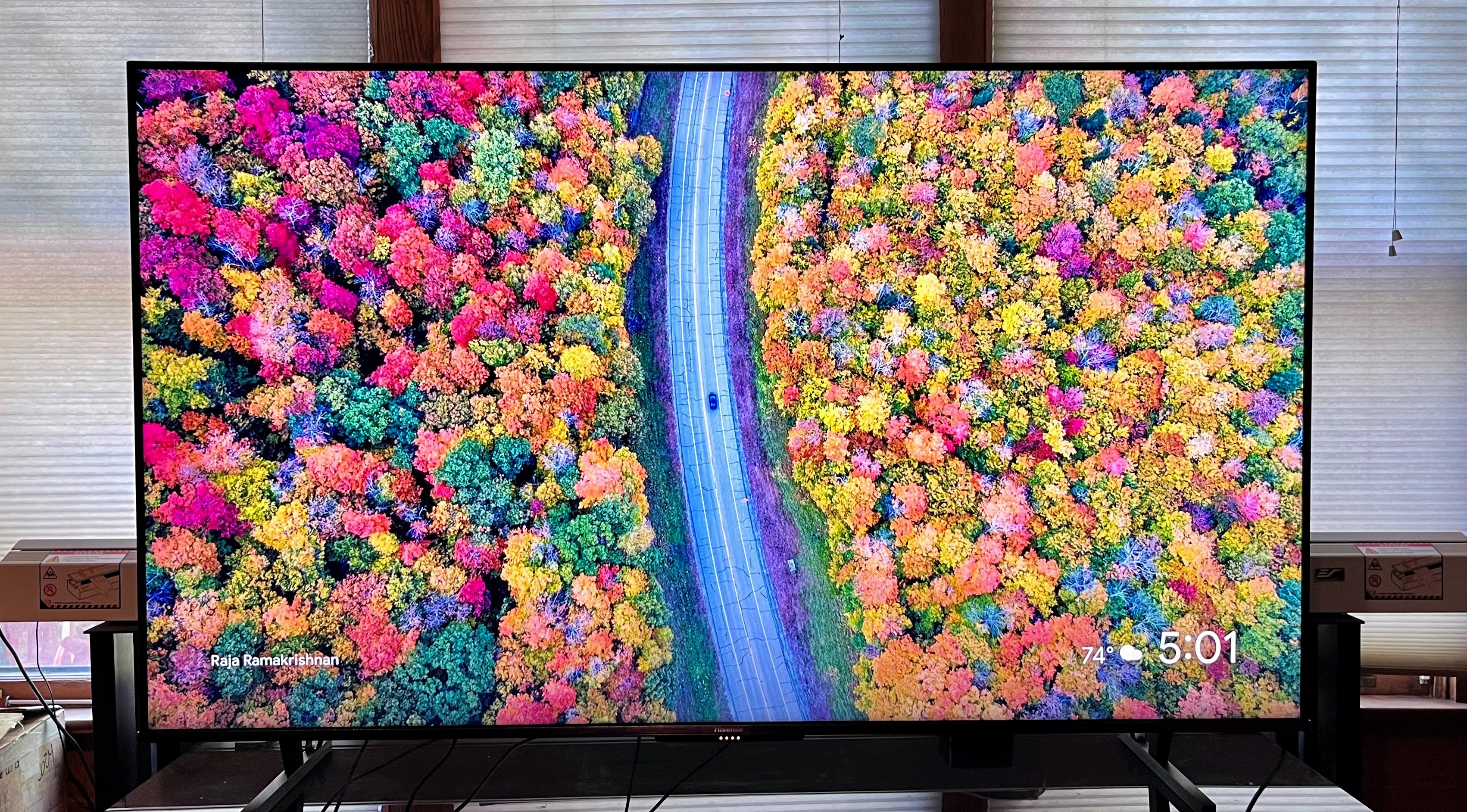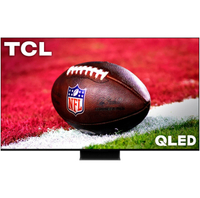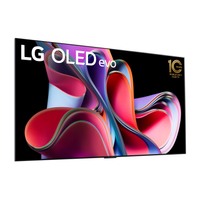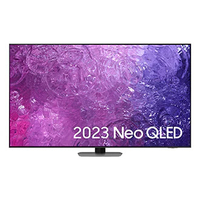TechRadar Verdict
Hisense went all-in on mini-LED TVs for 2023 and the U8K is its top mini-LED series. Its mini-LED tech delivers the high brightness viewers expect, while its full array local dimming offers the deep black shadows movie fans love. Best of all, it does all this at an incredibly competitive price point, making the Hisense U8K seriously good value. Google TV runs the show here for streaming and hands-free voice commands (though there is also an Alexa control option) and there is comprehensive gaming support, with dual HDMI 2.1 ports with 4K 144Hz input. There are plenty of other features that make the U8K special, and a TV well worth considering if you’re seeking out a high-value and high-performance option.
Pros
- +
High brightness
- +
Affordable given features and performance
- +
ATSC 3.0 tuner
Cons
- -
Some backlight blooming
- -
Contrast fades off-center
- -
Setup menus require digging
Why you can trust TechRadar
Editor's note
• Original review date: August 2023
• Hisense U8N due in 2024
• Launch price: From $1,299/£1,299 (55-inch)
• Target price: From $699/£999 (55-inch)
Update: February 2024. Mini-LED TVs don’t have to be expensive any more, and the Hisense U8K is living proof of this. It still ranks highly in our guide to the best TVs due to its high brightness and gaming features for a terrific price these days. The U8K is regularly discounted now, and you can get the 65-inch model for $899 / £1,299 / AU$1,995, which is a fantastic deal for a TV with its features at that size. We don’t know exactly when its successor, the Hisense U8N will arrive, but we don’t expect that TV to be a game-changing upgrade over this one – especially as this TV has already held its own against the likes of the TCL QM8 and Samsung QN85C. The rest of this review remains as previously published.

Hisense U8K Series TV: Three-minute review
I was very impressed with the Hisense U8H series TV when I reviewed it in 2022, mostly due to its very good overall picture quality and low price. The U8H was undoubtedly great value for a mini-LED TV, many of which are priced at the level where you might be inclined to consider one of the best OLED TVs instead.
While the U8H was Hisense’s only mini-LED offering at the time, the company has doubled-down on the tech for its 2023 lineup. The U8K models lead off three distinct mini–LED series, with the differences between them mainly being peak brightness capability and the number of full array local dimming zones. Audio performance is another differentiating factor, with the U8K series sporting a built-in 2.1.2 Dolby Atmos speaker system.
While the new U8K doesn’t surpass its predecessor on the peak brightness front, its local dimming performance is very good, with only a few instances of backlight 'blooming' effects to distract when watching movies in a dark room. Brightness here is sufficient for the U8K to look good when viewing in daylight conditions, and the TV’s anti-glare screen helps to reduce any onscreen reflections from overhead lamps.
Hisense uses the Google TV interface for the U8K series, and it handily does the work of organizing your streaming apps and providing voice control for content searches and other functions, either using the TV’s built-in mic or the one in the set’s remote control. And while the Google TV interface is layered with personalized movie, TV series and YouTube video recommendations, there are also options to create a more streamlined look. Google TV additionally provides a Live menu that shows current free streaming channels, along with digital TV broadcasts ones pulled in by the set’s ATSC 3.0 tuner.
As for design, the Hisense U8K isn’t as slim and elegant as some of the more expensive examples of the best 4K TVs, but it has a slim bezel and a sturdy set of support feet. These can also be set to a narrow or a wider placement to clear space for a soundbar.
Gaming is one of the U8K’s strong points. The TV has a pair of HDMI 2.1 ports, and they support up to a 4K 144Hz input, along with VRR, ALLM, and FreeSync Premium Pro. Unlike some other top TVs, there’s no onscreen hub that compiles cloud gaming services, but the TV will automatically switch to a low input lag Game mode when an input from an Xbox or PS5 console is detected.
Another U8K strong point is value. It’s considerably less expensive than its mini-LED competition, while offering many of the same features and much of the same performance. I think most people will be very happy with what they’re getting here, whether the TV is used for movies, sports or gaming.
Hisense U8K Series TV review: Price and release date
- Release date: June 5, 2023
- 55U8K: $1,099
- 65U8K: $1,399
- 75U8K: $1,949
- 85U8K: $2,999
The Hisense U8K series is the company’s top mini-LED TV line for 2023 (a limited edition ULED X model is also available, but only in an 85-inch screen size). There are two additional lines that use mini-LED backlighting, the U7K and U6K, with the difference between them being specified brightness and number of full array local dimming zones.
Pricing for the U8K series is highly competitive and appears set to not only put Hisense’s bigger-brand mini-LED competition – most notably Samsung and Sony – on notice, but fellow budget-oriented brand TCL as well. Prices for U8K series TVs have also dropped by quite a bit since they first shipped in June, with the 65-inch model I tested now selling for 25% less than its initial cost.
At the time of this review, the 85-inch U8K was not available, though Hisense says it should ship in late August or September 2023.
Hisense U8K Series TV review: Specs
| Screen type: | QLED with mini-LED |
| Refresh rate: | 144Hz |
| HDR support: | Dolby Vision IQ, HDR10+, HDR10, HLG |
| Audio support: | Dolby Atmos, Dolby Digital |
| Smart TV: | Google TV |
| HDMI ports: | 4 HDMI ( 2 x HDMI 2.1, 1 with eARC) |
| Built-in tuner: | ATSC 3.0 |
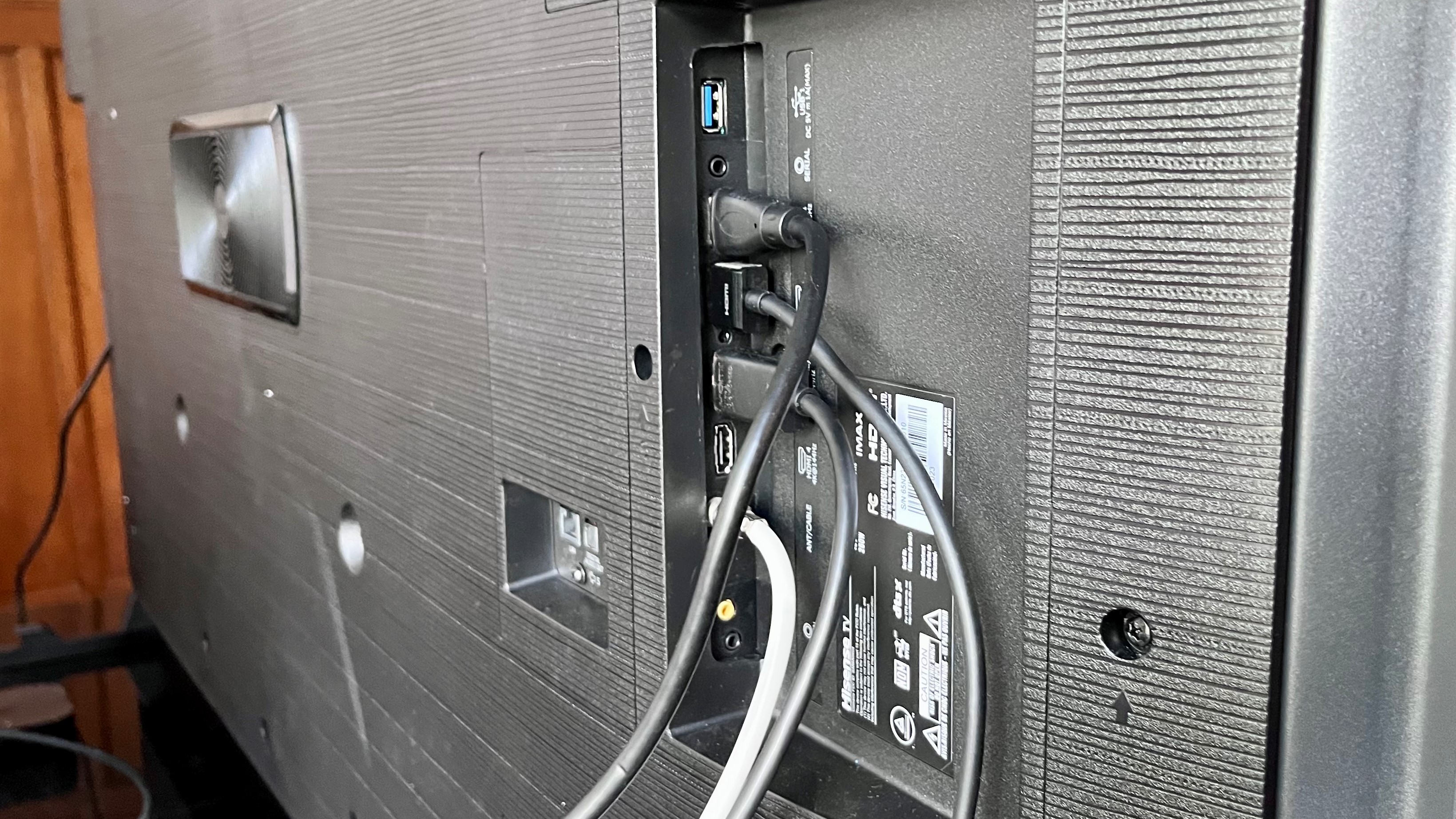
Hisense U8K Series TV review: Features
- Mini-LED backlight with local dimming
- Dolby Vision IQ and HDR10+ high dynamic range
- 4K 120Hz support with up to 144 Hz VRR for gaming
The U8K series TVs use a mini-LED backlight with full array local dimming. Hisense lists the local dimming zone count at “over 1,000” and peak brightness at 1,500 nits. High dynamic range support includes the Dolby Vision (IQ), HDR10, HDR10+, and HLG formats, and there are Filmmaker and IMAX Enhanced picture modes along with an anti-glare screen to reduce screen reflections in bright rooms.
Hisense uses Google TV as a smart TV interface for the U8K series. A built-in mic gives you a hands-free voice command option (the microphone can also be switched off) and there’s also a button-activated mic on the set’s remote control. Beyond Google Assistant, the U8K has an Alexa voice control option, and it supports Apple HomeKit and AirPlay 2 for streaming from an iPhone or iPad. Chromecast built-in provides yet another streaming option.
Two of the TV’s HDMI ports support up to 4K 144Hz input from a next-gen gaming console. There’s support for VRR, ALLM and FreeSync Premium Pro, and an onscreen Game Bar menu lets you make gaming-related adjustments on the fly while playing. Additionally, the set has a built-in ATSC 3.0 tuner to receive 'NextGen' digital TV broadcasts.
The TV's audio system uses a 2.1.2 Dolby Atmos speaker system with 50 watts total power, with an Acoustic Tuning Adjustment providing automatic sound calibration. One of its HDMI outputs supports eARC for connecting to an external soundbar – something the TV’s width-adjustable support feet are designed to accommodate – and there’s also a WiSA option for wirelessly connecting WiSA-certified speakers to the TV.
- Features Score: 4.5/5
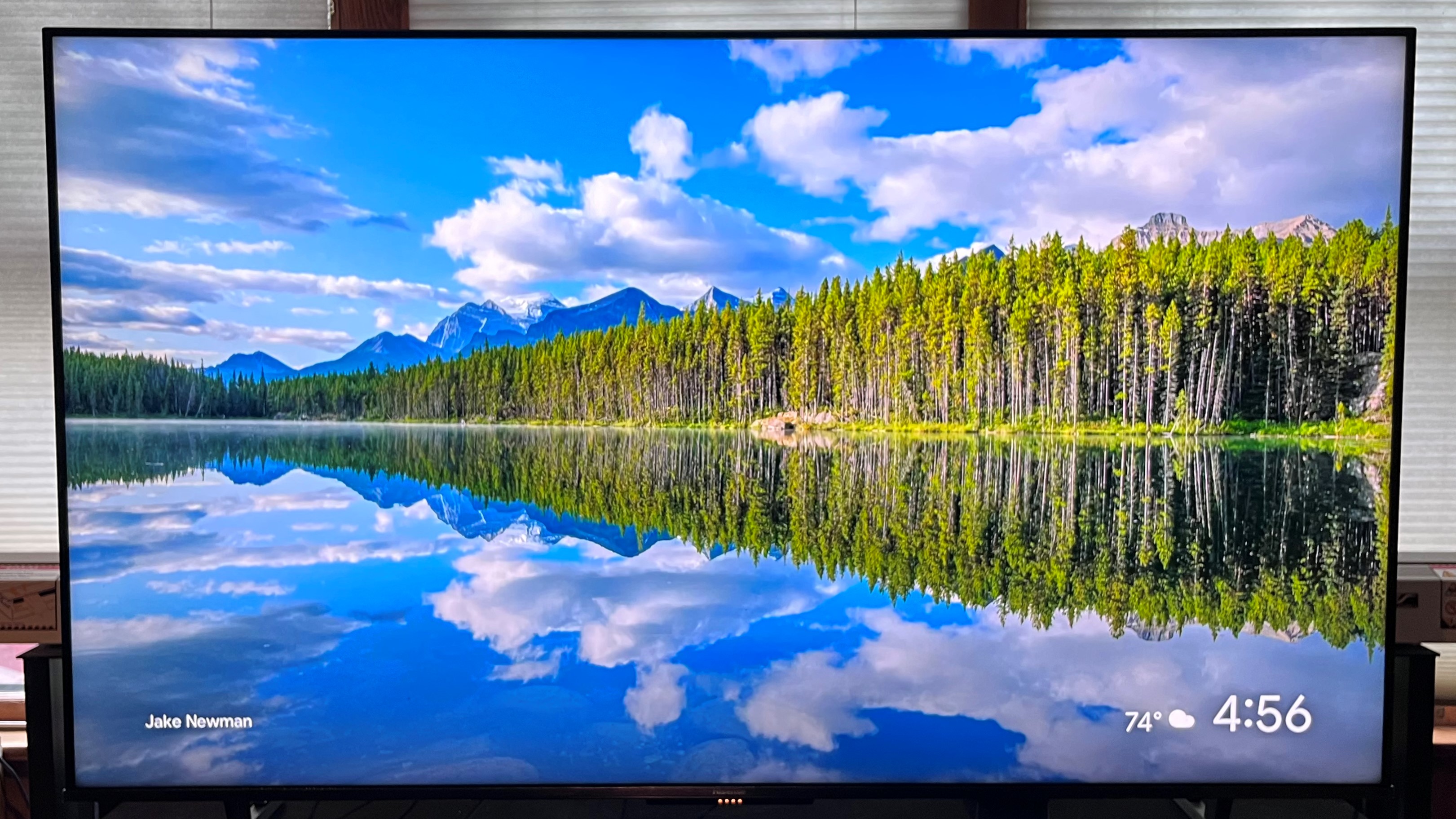
Hisense U8K Series TV review: Picture quality
- High peak brightness
- Deep blacks with detailed shadows
- Some backlight blooming
I reviewed a 65-inch U8K, which managed to beat Hisense’s brightness spec for the series. Peak brightness measured 1590 nits on a 10% white window pattern with the TV set to HDR Theater mode, which is notably higher than the 905 nits I measured in Fillmmaker mode on last year’s U8H series model. A white pattern covering 100% of the TV’s screen hit 760 nits, which is similarly impressive performance for that test.
With the TV’s Local Contrast (local dimming) set to High, its backlight fully switches off when displaying a full black test pattern, resulting in 'infinite' contrast. Both black and white uniformity is very good, though a degree of backlight blooming could be seen when displaying white movie titles against a black background (or red titles in the case of the film Babylon) or on black letterboxed bars where a bright object is shown at the top or bottom of the image.
In the TV’s Filmmaker picture mode, measured grayscale Delta E values averaged out to 4.1 (we typically look for these to clock in below 3) with a high of 6.3. Measurements made with Portrait’s Calman color calibration software showed coverage of DCI-P3 (the color space used for mastering 4K Blu-rays and digital cinema releases) to be 97%, and BT.2020 to be 80%, both of which are excellent results.
An anti-glare screen coating on the U8K did a great job of reducing reflections from the overhead lights in my room. As with other LCD TVs with a vertical alignment (VA) panel, picture contrast and color saturation took a hit when viewing the TV from far off-center seats.
After breaking the TV in for a few days with casual viewing, I started out my critical viewing with the demonstration section of the Spears and Munsil Ultra HD Benchmark disc. Watching the version graded for 2,000 nits peak HDR brightness, I could see occasional banding artifacts in clouds, though the same issues disappeared when I watched it at 1,000 nits – a far more common peak brightness level for HDR programs. The disc's starfield sections also revealed a degree of backlight blooming, which showed up in the form of an elevated black level over what you would see on an OLED display, a TV tech that doesn’t use a backlight.
With the TV in Filmmaker mode, there was a notable degree of judder and blur in film scenes with camera motion. Watching a scene from the James Bond film No Time to Die, for example, a shot where the camera pans across a cemetery on a craggy hillside showed significant artifacts of both types. Fortunately, the TV’s Clarity menu provides independent Judder and Blur adjustments to minimize such artifacts, and it’s possible to create a setting that doesn’t also introduce a significant “soap opera effect” – something that the other Clarity presets generate.
Whether I was watching news channels with the lights on or streaming movies and shows with them dimmed, everything looked very good on the U8K. The Netflix movie They Cloned Tyrone has a dark and grainy-looking image, and both the shadows and grain were well handled by the Hisense. A brighter option was presented by the Apple TV Plus series Hijack, with strong HDR highlights in many of the scenes. On the U8K, these came across in a balanced and detailed manner, and there was a consistently natural look to the images.
- Picture quality score: 4.5/5
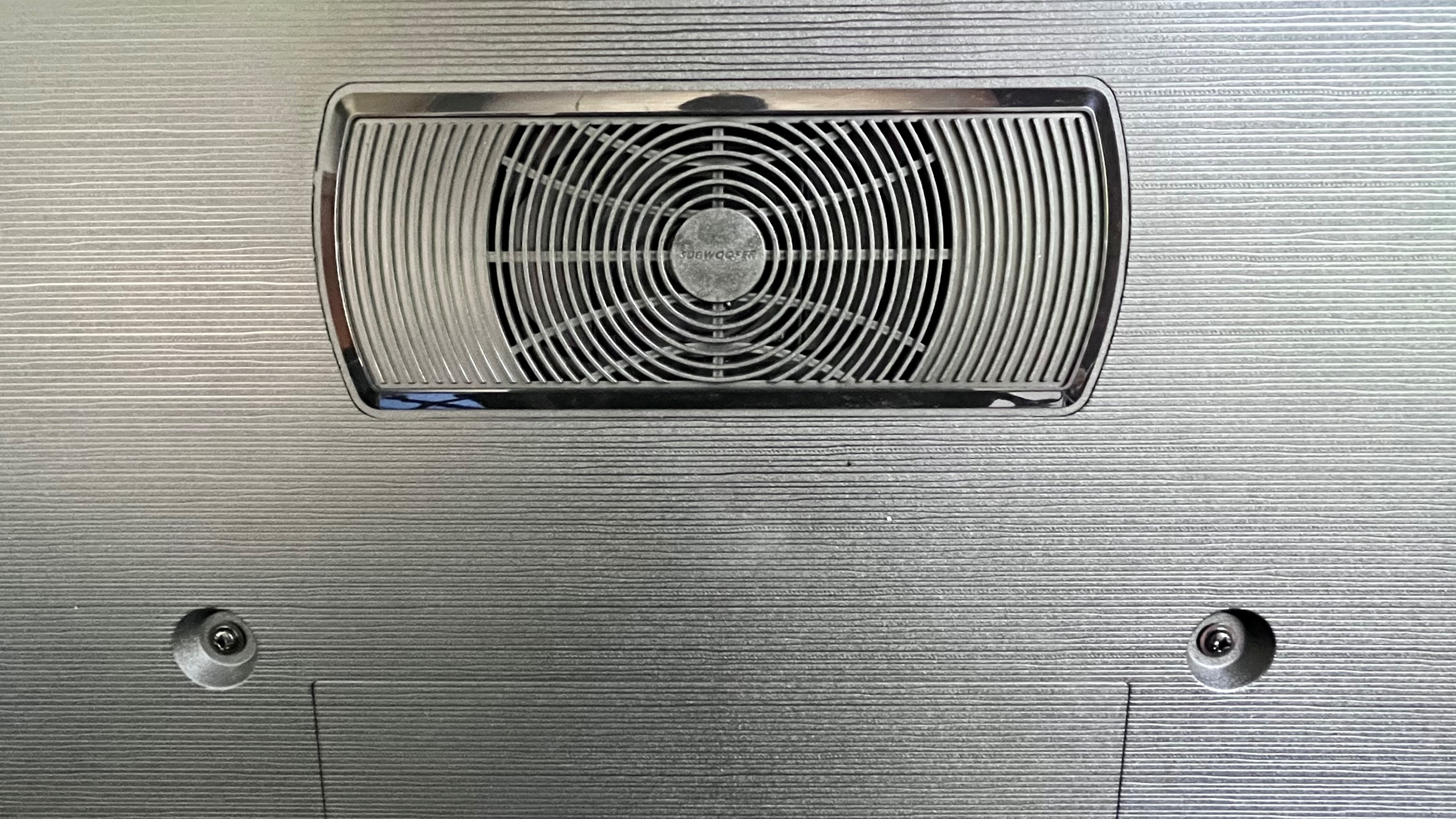
Hisense U8K Series TV review: Sound quality
- 2.1.2 channel speakers
- Good dialogue clarity, decent bass
- Auto Acoustic Tuning mode
The U8K’s 2.1.2 speaker system is powered by a total of 50 watts and includes a subwoofer built into the set’s rear panel. Overall, the TV’s sound quality is quite good. Dialogue sounds clear and the speakers can get fairly loud before you start to hear any signs of strain.
The TV’s two upfiring speakers add a sense of spaciousness to Dolby Atmos soundtracks, though the effect is nothing like what you’d get when using the best Dolby Atmos soundbars. There’s also an Auto Acoustic Tuning mode that uses the mic built into the TV to equalize the sound, though you shouldn’t expect to hear a night and day difference when using it.
Other audio features include a Late Night mode (useful for reducing overall dynamic range without affecting dialogue clarity) and a multi-band equalizer to dial in the sound to your liking.
- Sound quality score: 4/5
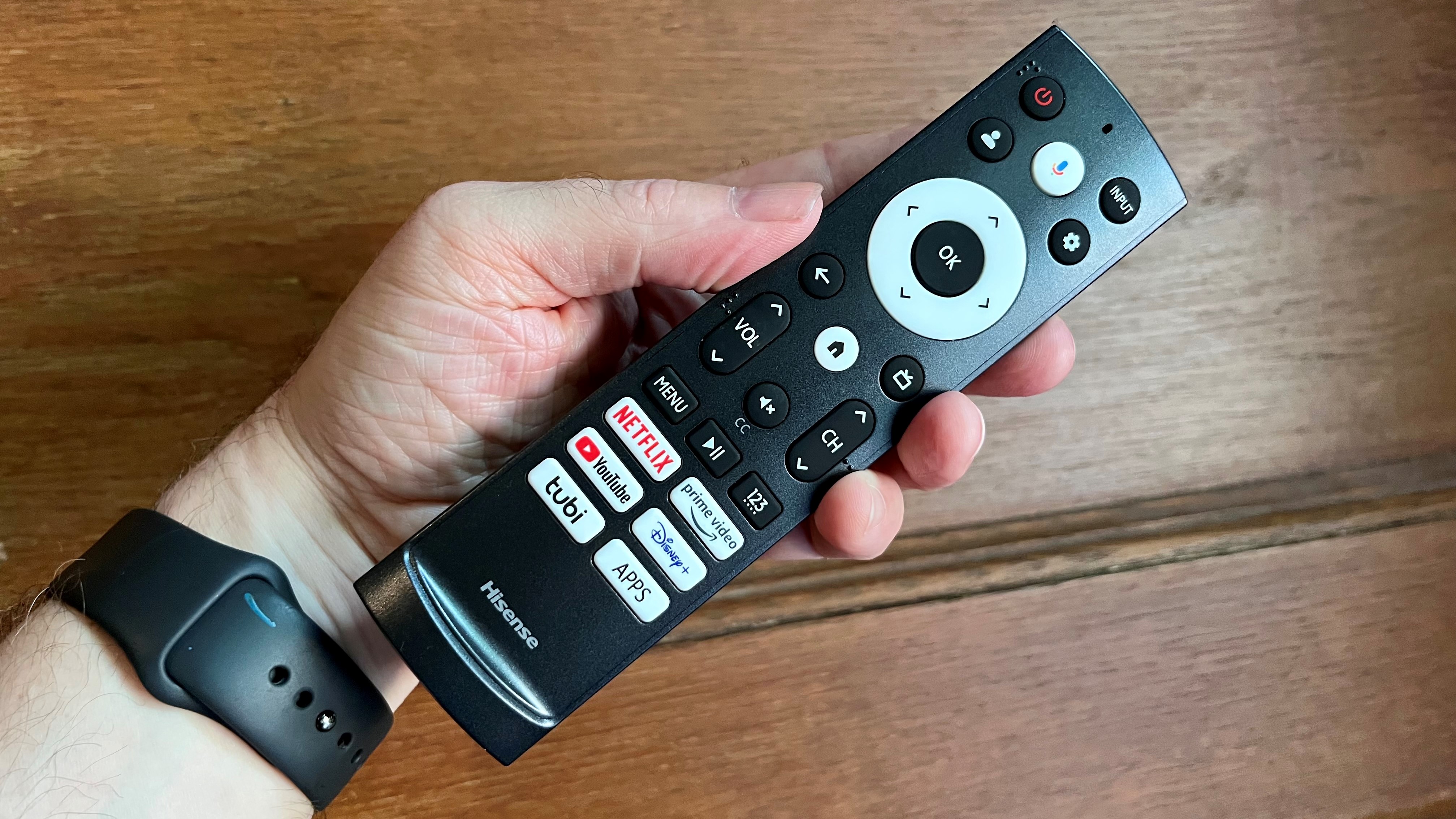
Hisense U8K Series TV review: Design
- Slim form factor
- Adjustable-width support feet
- ATSC 3.0 tuner
The U8K series TVs have a basic but good overall look, with a slim bezel and adjustable width support feet. Being able to set the feet to either a wide or narrow width gives you a greater range of placement options, and it also helps make space for a soundbar.
At three inches deep, the U8K series lacks the incredible slimness of high-end TVs from Samsung and LG, though that’s not surprising as its casing accommodates a back-mounted subwoofer. A strip of LED indicator lights is located on a narrow panel at the set’s bottom, and a switch to turn the TV’s built-in mic is located on the same panel.
The TV’s side-mounted inputs include four HDMI ports (two HDMI 2.1 with support for 4K at 144Hz and one with eARC). There are also optical digital audio and wired headphone outputs and a powered USB port. An RF input lets you connect an antenna, and the set’s built-in digital TV tuner has support for next-gen ATSC 3.0 broadcasts.
Hisense’s compact remote control provides only a basic button set. There are controls for volume and channel selection, as well as ones to access setup menus, Google TV profiles, a built-in mic for voice control, and video inputs. A six-pack of buttons on the bottom also provides direct access to popular apps such as Netflix, Amazon Prime Video and Disney Plus.
- Design score: 4/5
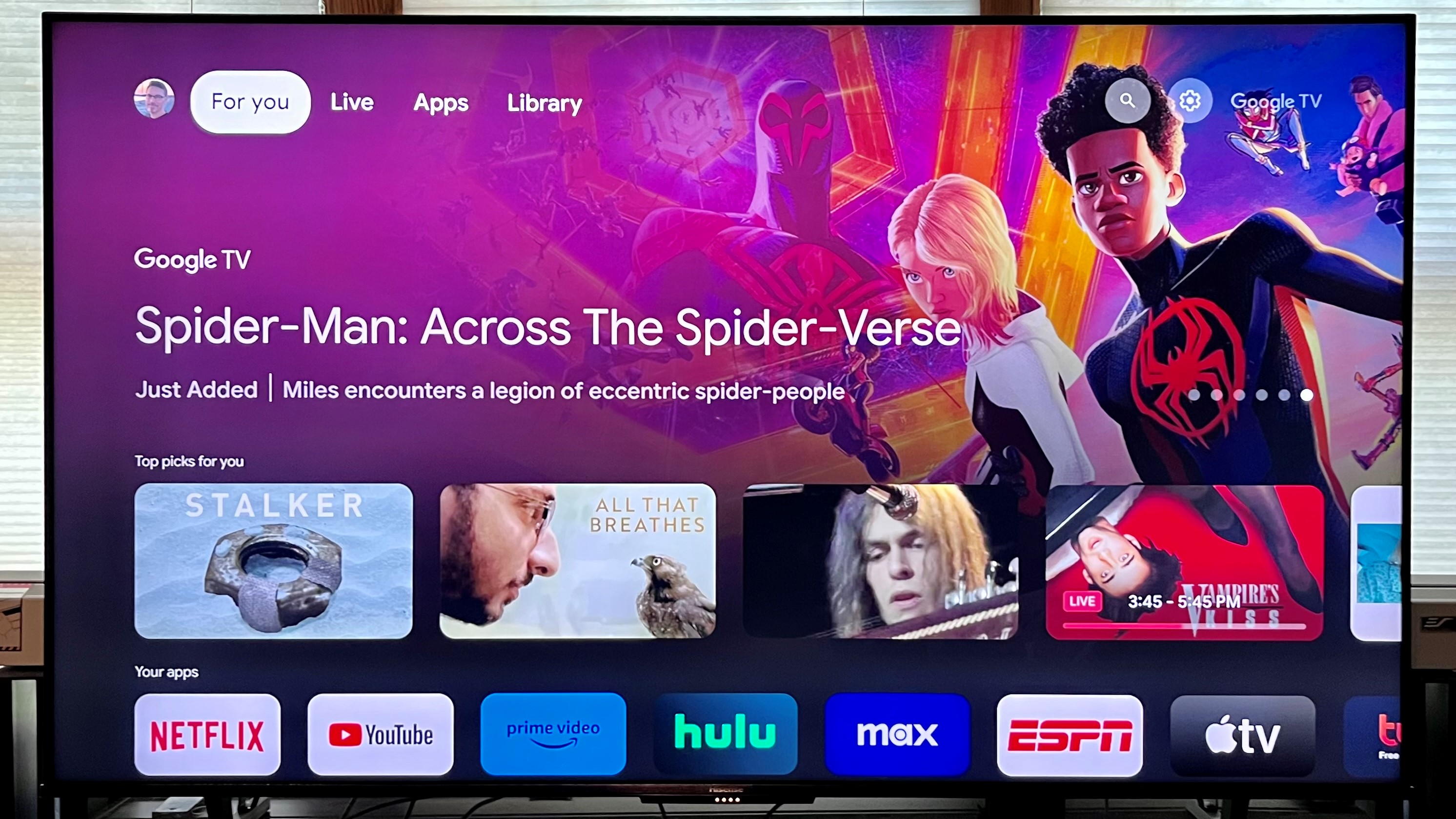
Hisense U8K Series TV review: Smart TV and menus
- Google TV interface
- Hands-free voice command that works with Alexa and HomeKit
- Setup menus can be annoying to navigate
Hisense uses the Google TV smart interface for the U8K series. Like many smart TV interfaces, the home screen is loaded up with content recommendations, though Google TV also has an “Apps Only” mode that creates a more stripped-down presentation when enabled. Entering your Google account credentials or creating a new account, will provide you with personalized content recommendations, with the results based both on your viewing history and Google Chrome browsing activity. Multiple accounts can be created, which allows everyone in the household to have their own Google TV “experience”.
The TV’s built-in mic lets you use hands-free voice commands for content searches and basic control such as volume adjustment and input selection. You can also switch the mic off and instead use the built-in one on the remote, which is temporarily activated when you press the microphone button. Along with Google Assistant, the U9K works with Amazon’s Alexa and Apple’s HomeKit, and you can wirelessly cast videos to it using Chromecast built-in and AirPlay 2.
Google TV’s Live TV portal presents a time-based guide featuring free-to-stream (ad-supported, of course) channels, with everything from movies to national news to cooking shows on the menu. With one of the best indoor antennas connected, you can also select a Tuner option to see a guide listing live programs from your local broadcast TV channels. Interestingly, the guide flags any ATSC 3.0 channels, so you can easily tell which stations in your area have been upgraded for “NextGen” digital TV.
The U8K’s setup menus can be a bit confusing to navigate at first, though you’ll soon enough find what you’re looking for. A Picture menu includes sub-menus for options like Brightness, Color and Clarity, with various related adjustments available for each category. It’s a comprehensive list to be sure, and fanatical picture tweakers will find much here to play with. The downside is that doing something as simple as adjusting picture brightness takes multiple remote button presses to get to a specific control. Also, the setup menu takes up half of the screen area, which makes it difficult to see the effects of your adjustments.
- Smart TV and menus score: 4/5
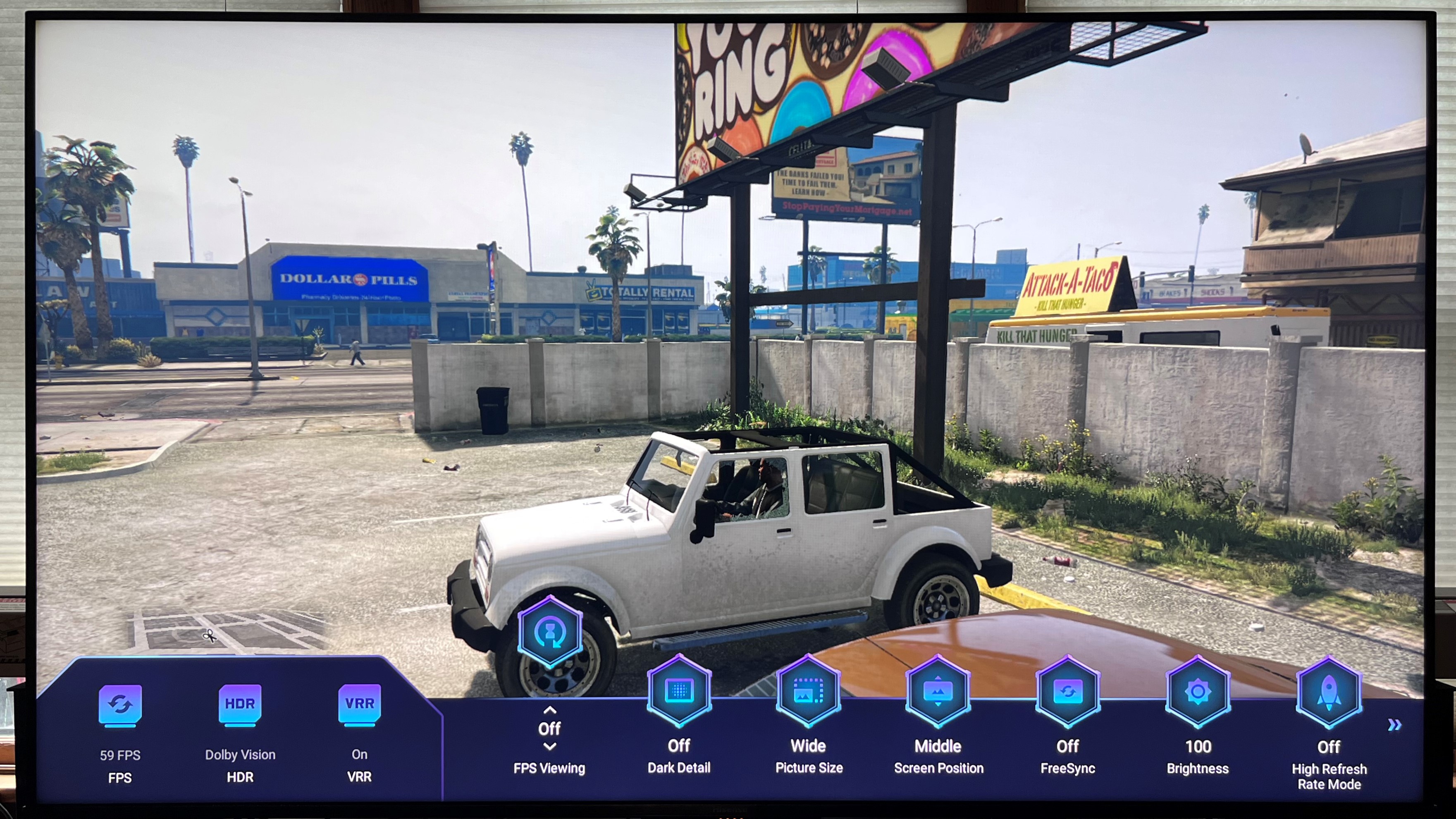
Hisense U8K Series TV review: Gaming
- 4K 144Hz with VRR and FreeSync Premium Pro
- No native cloud gaming portal
- 13ms input lag
With a pair of HDMI 2.1 ports and support for up to 4K 144Hz input, the U8K series is a great option for gaming. The Hisense also supports VRR, ALLM and FreeSync Premium Pro along with Dolby Vision gaming at 4K 144Hz. Google TV currently doesn’t offer a gaming option with native support, though you can find the Nvidia Geforce Now app in the Google Play store.
Measured using a Bodnar 4K HDMI tester with the U8K in Game mode, input lag on the U8K was 13ms, which is an average performance. When a game console input is detected, the U8K’s ALLM (auto low latency mode) feature automatically switches the TV to Game mode, and you will be able to use an onscreen game menu to adjust settings like Brightness, Dark Detail, Picture Size and High Refresh Rate Mode.
- Gaming score: 4/5
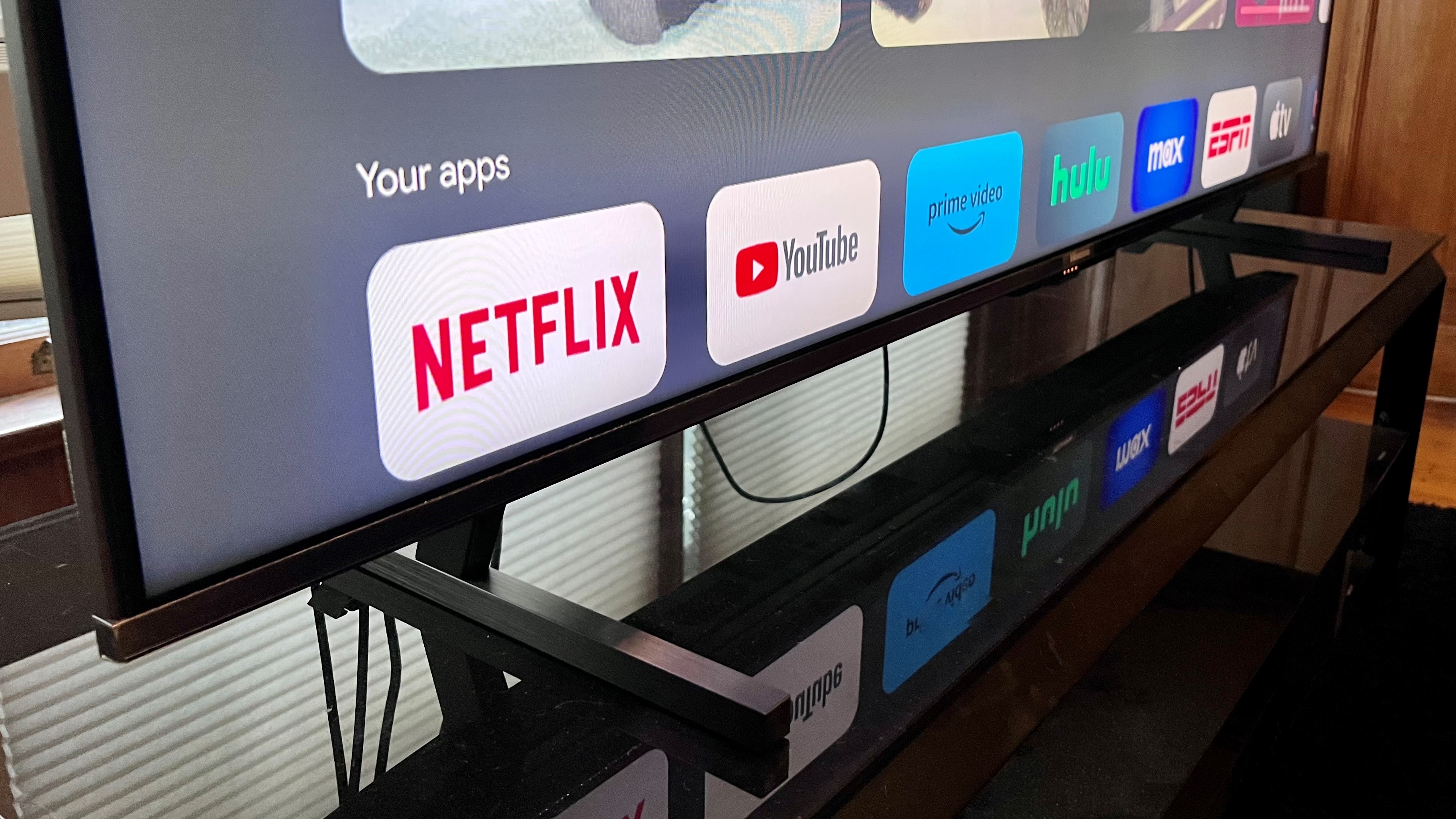
Hisense U8K Series TV review: Value
- Cheaper than the mini-LED TV competition
- Great performance for the price
- Maximum brightness is less than competition
Priced at $1,399 and selling for significantly less than that just two months after being released, the Hisense U8K is fantastic value. You’ll pay a good deal more for mini-LED TVs from Sony and Samsung, though those models are likely to offer features not found on the U8K, such as soundbar audio integration and a cloud gaming hub.
The U8K is also priced lower than the TCL QM8, a 2023 mini-LED TV that we favorably reviewed. What are the differences between the two? Brightness mainly, with the TCL TV managing to hit 2,321 nits peak light output as compared to the Hisense’s nearly 1,600 nits. Otherwise, the two share similar features and gaming specs, and both use the Google TV smart interface for streaming.
- Value score: 5/5
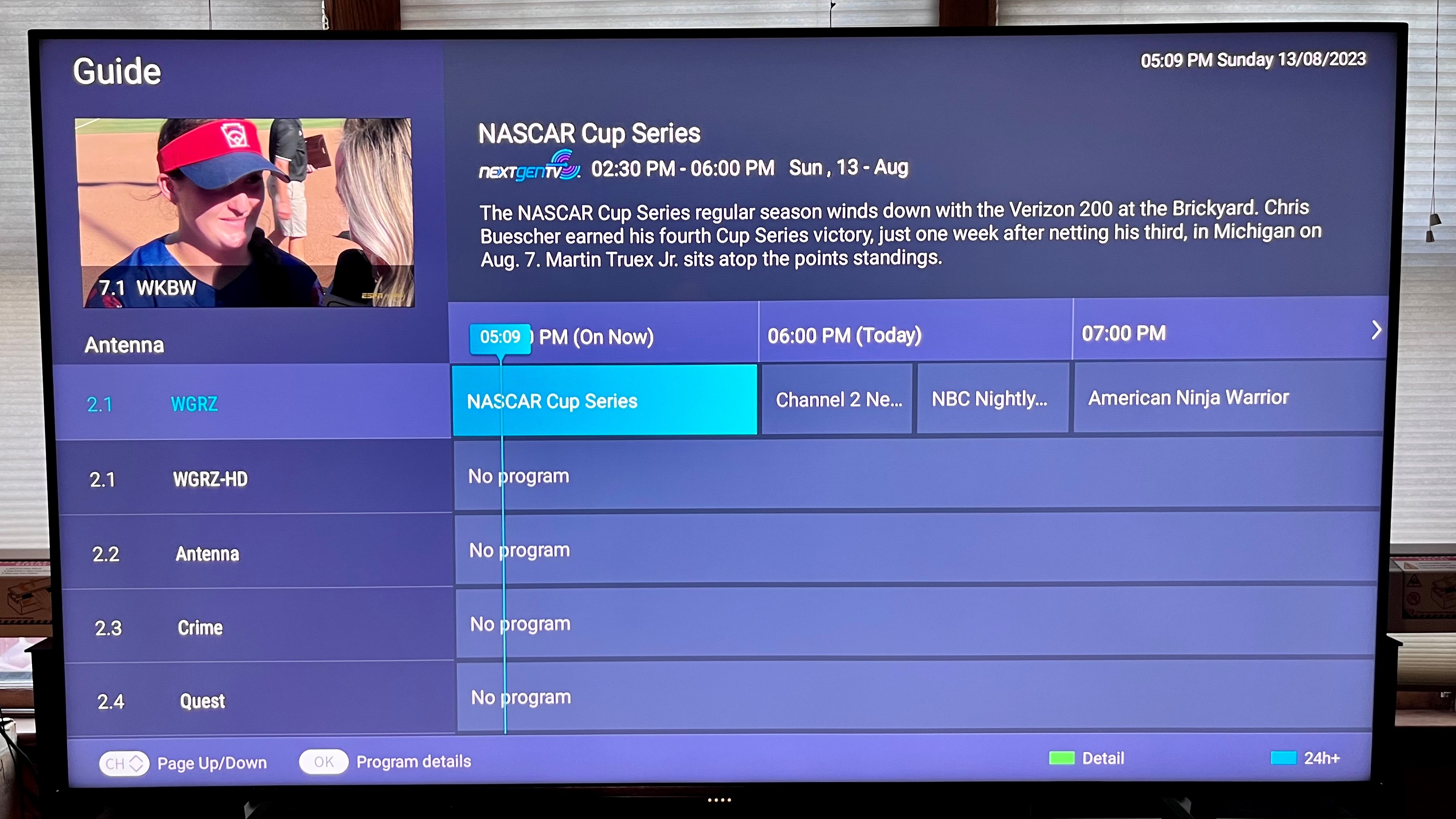
Should I buy the Hisense U8K Series TV?
| Attributes | Notes | Rating |
|---|---|---|
| Features | A solid feature mix for movies, gaming, and basic TV watching | 4.5/5 |
| Picture quality | Impressive overall performance, though with some limitations | 4.5/5 |
| Sound quality | Good bass and dialogue clarity, with a hint of Atmos spaciousness | 4/5 |
| Design | Basic but good looks with adjustable-width support feet | 4/5 |
| Smart TV and menus | Google TV interface good overall, though setup menus can be cumbersome | 4/5 |
| Gaming | Very good gaming features, but no built-in cloud-gaming option | 4/5 |
| Value | An excellent value for a bright TV with a mini-LED backlight | 5/5 |
Buy it if...
You have a limited budget
Hisense U8K series TVs are among the least expensive mini-LED models you can buy, but performance-wise compete well with pricier models. Demanding viewers who also want to save money should look no further.
You plan to view in a bright environment
Mini-LED TVs like the U8K are capable of high light output, making them an obvious choice for viewing sports and other programs in bright rooms. In such an environment, the TV’s anti-glare screen will help eliminate reflections from overhead lights.
You want a TV with an ATSC 3.0 tuner
The U8K’s built-in ATSC 3.0 tuner is a feature typically found on high-end sets that lets you view programs broadcast in the next-gen digital TV format. If broadcast TV is something you take advantage of, the U8K is a future-proof option.
Don't buy it if…
You want a perfect TV
The U8K has great overall picture quality, but it's bested by OLED and QD-OLED models when it comes to shadow uniformity and detail. You can also expect better local dimming performance from some other, more expensive mini-LED TVs.
You want a TV that looks good from any angle
The U8K’s picture looks fine over a relatively limited viewing window, but contrast and color fades when watching from far off-center seats. This won’t be an issue in most situations, but it doesn’t make the Hisense the best option for viewing with a large group.
You want a basic TV
Google TV does the job for streaming and other functions, but navigating its interface and settings can be a drag when you want to do something basic like adjust picture brightness. Other TVs have more streamlined controls and are recommended for those with limited patience.
Also consider...
| Hisense U8K | TCL QM8 | LG C3 | Samsung QN90C | |
|---|---|---|---|---|
| Price (65-inch): | $1,399 | $1,699 | $2,600 | $2,299 |
| Screen type | QLED with mini-LED | QLED with mini-LED | OLED | QLED with mini-LED |
| Refresh rate | 144Hz | 144Hz | 120Hz | 120Hz |
| HDR support | Dolby Vision, HDR10, HDR10+, HLG | Dolby Vision, HDR10, HDR10+, HLG | Dolby Vision, HDR10, HLG | HDR10+, HDR10, HLG |
| Smart TV | Google TV | Google TV | webOS 23 | Tizen |
| HDMI ports: | 4 (2x HDMI 2.1) | 4 (2x HDMI 2.1) | 4 HDMI 2.1 | 4 HDMI 2.1 |
| Built-in tuner | ATSC 3.0 | ATSC 1.0 | ATSC 1.0 | ATSC 3.0 |
TCL QM8 mini-LED
TCL’s QM8 Class TVs also feature a mini-LED backlight and are capable of even higher peak brightness than the Hisense U8K. Both otherwise have a similar feature set, though the QM8 TVs are a bit pricier than the U8K series.
Read our TCL QM8 mini-LED TV review.
LG C3 OLED
Spending a bit more will get you this mid-range LG OLED TV, which provides all-around excellent picture quality, but lower peak brightness. It’s also a great option for gaming, with similarly low input lag and 4K 120Hz, VRR, FreeSync Premium Pro and Nvidia G-Sync support.
Read our LG C3 OLED TV review.
Samsung QN90C mini-LED
Samsung’s Neo QLED model is pricier than the QN90C, but it offers higher peak brightness along with refined local dimming. It also has an anti-glare screen and an excellent suite of gaming features, including 4K 120Hz support and Samsung’s Game Hub for cloud-based gaming.
Read our Samsung QN90C mini-LED TV review.
How I tested the Hisense U8K TV
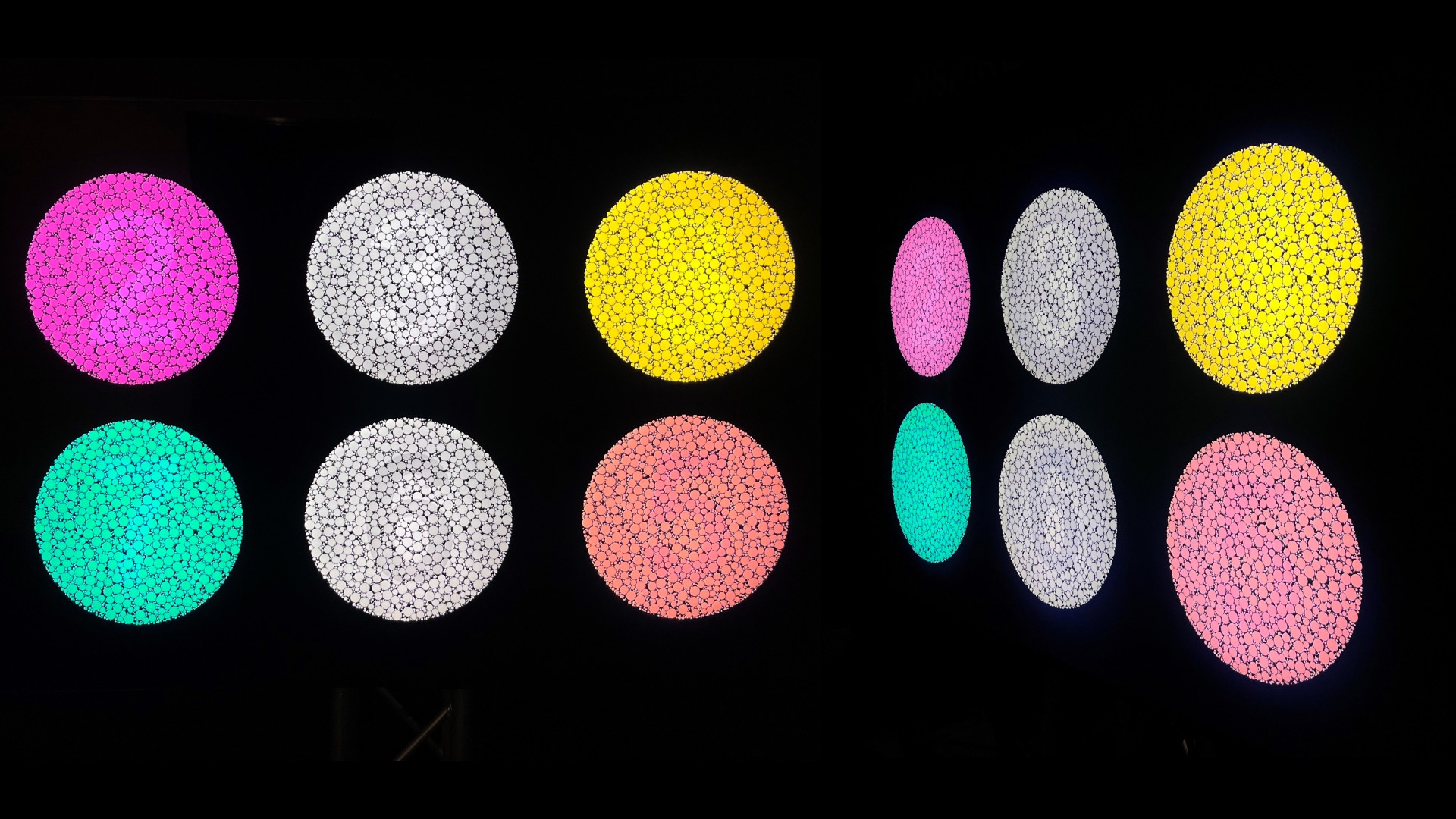
- I spent about 15 hours in total measuring and evaluating
- Measurements were made using Calman color calibration software
- A full calibration of the TV was made before proceeding with subjective tests
When I test TVs, my first step is to spend a few days using it for casual viewing for break-in and to assess the out-of-box picture presets. The next step is to select the most accurate-looking preset (typically labeled Movie or Cinema) and measure the white balance (grayscale), gamma and color point accuracy using Portrait Displays’ Calman color calibration software. The resulting measurements provide Delta-E values (the margin of error between the test pattern source and what’s shown on-screen) for each category, and they allow for an assessment of the TV’s overall accuracy.
Along with those tests, I make measurements of peak light output (recorded in nits) for both standard high-definition and 4K high dynamic range using 10% and 100% white window patterns. Coverage of DCI-P3 and BT.2020 color space is also measured, with the results providing a sense of how faithfully the TV can render the extended color range in ultra high-definition sources.
For the Hisense U8K, I used the Calman ISF workflow, along with the TV’s advanced picture menu settings, to calibrate the image for best accuracy with SDR and HDR sources. Once done, I watched a range of reference scenes on 4K Blu-ray discs that I’ve gathered after years of TV and projector testing to assess the TV’s performance, as well as new Dolby Vision-encoded material streamed from sources like Netflix and HBO Max.
- First reviewed: August 17, 2023

Al Griffin has been writing about and reviewing A/V tech since the days LaserDiscs roamed the earth, and was previously the editor of Sound & Vision magazine.
When not reviewing the latest and greatest gear or watching movies at home, he can usually be found out and about on a bike.
